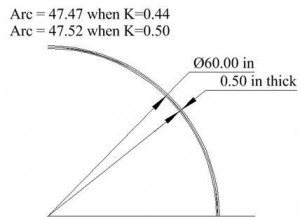Designers, detailers, and fabricators commonly debate the correct formula for a blank length of bent plates. A trial run is always good practice when forming on a press brake because metals stretch so differently on different setups.
This confusion does not need to carry over into the rolling of plate, since the radius is larger than 3 times the thickness.
The K-factor of a bend is the ratio of the neutral axis to the thickness, so when K = 0.50, the neutral axis is in the exact center of the thickness: half the thickness compresses and half of it stretches. On very tight bends, however, the K value changes where the material stretches more than it compresses.
Most of today’s 3D CAD software such as SolidWorks or AutoCAD Inventor will “unfold” a 3D model. The AutoCAD default K value is 0.44, which is the standard for steel with bend radii of 1 to 3 times the thickness.
For rolled items, however, you should set your software to K = 0.50.
Perhaps this debate still exists because the K = 0.44 is close enough when rolling large radii.
Looking at an example of 1/2″ plate to 60″ inside diameter, there is only 3/64″ difference over a 90deg segment. The K-value is not as important on large radii, but if you are a stickler for accuracy use K = 0.50 when rolling.








